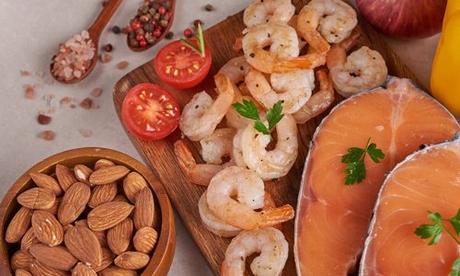Dieting has become one of the trendiest things in today's world. While it is essential for people who are overweight or obese, or for those who suffer from disorders like diabetes, many try to follow a diet due to peer pressure. You might have heard of the low-carb diet, vegan diet, ketogenic diet, etc. One such diet that's being followed widely by diet enthusiasts is the "paleo diet."
The paleo diet, rooted in the Stone Age or Paleolithic Era, includes foods like lean meats, fish, vegetables, nuts, and seeds. Poultry, dairy, grains, and processed foods are excluded. The diet's premise is that our genes haven't changed despite evolving food habits. This ancient diet is believed to maintain health better, challenging modern balanced meals.
According to health professionals recommending the paleo diet, the required nutrients can be obtained from the 'caveman diet', excluding modern food habits. The 'Discordance Hypothesis' highlights that modern diets conflict with our genes, contributing to obesity, cardiovascular diseases, hypertension, and diabetes. One of the notable facts about the paleo diet is that it doesn't prescribe a calorie count, setting it apart from most diets. It encourages physical activity and adequate water intake for stability. Despite controversies, it can be beneficial for significant weight loss. Know some facts about weight loss surgery and its limitations .
Other Names for Paleo Diet

While "paleo diet" is the most commonly used term, it is also known by these names:
List of Foods Suitable for the Paleo Diet - Change this to:
Paleo Diet Food List

The paleo diet focuses on consuming foods that our hunter-gatherer ancestors would have eaten. It promotes unprocessed foods that are rich in nutrients and excludes processed items and grains. It involves foods reflecting paleolithic eating, like some of the following.
- Meat: Lean meats like beef, lamb, pork, and poultry.
- Fish and Seafood: Fatty fish (salmon, mackerel) for omega-3s, plus shellfish.
- Eggs: A protein and healthy fat source.
- Fruits: All types, but consume in moderation.
- Vegetables: Non-starchy variety in different colors.
- Nuts and Seeds: Almonds, walnuts, pumpkin seeds, etc., in moderation.
- Healthy Fats and Oils: Olive oil, coconut oil, avocado oil.
- Herbs and Spices: Flavor enhancers like garlic, ginger, turmeric.
- Natural Sweeteners: Limited use of honey, and maple syrup.
- Beverages: Water, herbal tea, black coffee, coconut water in moderation.
Avoid grains, legumes, dairy, refined sugar, processed foods, vegetable oils, and additives.
What Is the Main Idea of the Paleo Diet?

Our ancestors, thousands of years ago, were involved in hunting, fishing, and gathering food. Many years later, people started farming. They got involved in agriculture and grew their grains. However, the main idea of the paleo diet is that our genes are not adapted to the consumption of products that were obtained as a result of farming/agriculture. Since we have the same genes as our ancestors, it would be wise for us to eat exactly what they consumed thousands of years ago.
The people who lived near the ocean consumed lots of fish and other seafoods. Those who were in the forests depended more on plants and other vegetation for consumption.
Therefore, we cannot eat the grains, legumes, dairy products, etc., that are obtained from farming because our genes are not tuned to these types of food items. So, it would make sense if we consume the same fruits, vegetables, fish, eggs, and nuts that our ancestors gathered and ate.
Paleo Diet Benefits

Discover the myriad benefits of the paleo diet! Embracing this dietary approach can lead to improved weight management, increased energy levels, and better blood sugar control. The paleo diet's focus on whole, unprocessed foods may also reduce inflammation and support digestive health. Many short-term studies suggest that the paleo diet helps maintain cholesterol and triglyceride levels. Switching over from other types of fatty meat to lean meat is better for health because lean meat contains more protein and less fat than the other types. Skinless chicken is an example of lean meat. Fish like salmon and other seafood are also included in the paleo diet. Here's what you must know about salmon .
Vegetables and fruits are rich sources of minerals, vitamins, and dietary fiber. Fiber is crucial for all people, especially individuals with diabetes because it plays a significant role in bowel movement. Other benefits of the paleo diet are given below.
- Weight Loss: High protein and fiber content in the diet promote weight loss.
- Heart Health: Less intake of processed foods can improve heart health.
- Reduced Inflammation: Anti-inflammatory foods, such as fruits, veggies, and nuts reduce overall inflammation.
- Improved Gut Health: High fiber fosters beneficial gut bacteria growth, improving gut health.
- Increased Energy: Nutrient-dense foods boost energy levels.
- Better Cognitive Function: Antioxidants protect the brain, enhancing cognitive function.
In addition to the above benefits, the diet has helped people find relief from the following health issues:
Is the Diet Easy to Follow?

Just like other diets, initially, the paleo diet will be challenging to follow. You might even face additional challenges when you start this diet because you will be avoiding some key food items you were consuming earlier.
In the beginning, you might experience a drop in energy levels, thereby feeling more lethargic. Or, you may experience digestive problems , changes in bowel movements, etc. However, these obstacles must not deter you from sticking to your diet. In case you undergo huge fluctuations in your body functions after starting this diet, consult your doctor immediately.
What Are the Pros and Cons of a Paleo Diet?
The paleo diet is a highly controversial one. While some people regard it as the perfect diet, others beg to differ. Some of the pros and cons of the diet are described below.
Pros

1. Rich in Protein
The seeds, nuts, and lean meat have excellent protein content, which is crucial for the muscles, bones, and skin. Protein also helps maintain a healthy body composition. Do you know if you must have protein before or after a workout?
2. Unsaturated Fats
The unsaturated fats present in nuts, olive oil, and avocados are beneficial for health because they assist in maintaining a healthy lipid profile.
3. Rich in Potassium
Potassium is essential for the proper functioning of the kidneys. It also regulates blood pressure. Potassium is found in fruits and vegetables, which form a large part of the paleo diet.
4. Improved Satiety
You won't be eating sugary processed food items like candies or salty snacks like chips. But you will be consuming foods rich in protein and fiber, which will make you feel fuller for longer periods.
5. Decreased Risks of All-Cause Mortality
The lower your risks of all-cause mortality, the better! This indicates that you are less likely to die from any cause of death. One of the major merits of following a paleo diet is that you are at decreased risks of all-cause mortality.
Cons

1. Deficiency in Some Nutrients
The paleo diet excludes many food items, such as dairy products, which are fabulous sources of calcium and other nutrients. So, these nutrients are not made available for people following the diet. Calcium deficiency can result in lower bone density. Lack of calcium even leads to tooth problems.
2. Evolution of Humans
The diet revolves around the fact that we have the same genes as our hunter-gatherer ancestors. However, the fact that humans have evolved over thousands of years is not taken into account. We have not only evolved, but our digestive systems have also become adapted to the changing environment. While our ancestors, from over 10,000 years ago, would have had a highly active life running about and hunting animals for food, people are currently more adapted to an inactive life. So, we cannot take the same fatty diet that our ancestors have consumed.
3. Legumes Are Not Included
Legumes are rich in magnesium, manganese, and selenium. Legumes are extremely important for gut health. But the paleo diet excludes legumes. So, humans might miss out on the gut health benefits. You have now seen the pros and cons of paleo diet. While some studies involving small groups of people state that the paleo diet is best for humans, a lot more research is necessary to confirm this theory.
4. Might Not Be Suitable for Continued Weight Loss
Since the diet is highly restrictive, people find it difficult to stick to it for long periods of time. So it might not be suitable for continued weight loss.
5. Increased Risks
Sometimes, people following the diet might experience increased risks of heart and kidney disease, and even some types of cancers.
Paleo Diet Recipes
Explore new and delicious recipes that satisfy the conditions of the paleo diet:
- Breakfast: Veggie frittata, avocado, and bacon combo.
- Lunch: Grilled chicken salad with homemade dressing.
- Snacks: Roasted nuts, fresh fruit, vegetable sticks with paleo-friendly dip.
- Dinner: Zucchini noodles, cauliflower rice stir-fry, grilled seasoned steak with colorful vegetables and herbs.
Is the Paleo Diet Better than Other Diets?

In the opinion of many, eating like our cavemen actually aligns with our genetics. However, over the years, people started consuming the products of agriculture, which has led to many chronic diseases, including allergies and obesity. So, eating what humans consumed in the Stone Age can prevent chronic diseases and maintain health. Avoiding refined sugar and processed foods reduces the risk factors for many diseases. So, for people following the paleo diet, the benefits of paleo diet outnumber the demerits.
On the other hand, consuming mostly animal products can increase the intake of cholesterol, especially the ones that are less healthy. In the long run, this dietary practice can result in increased risks of heart disease. Thus, we cannot say that the paleo diet is better than other diets. Long-term consumption of large portions of animal products can affect health in many other ways too. Do you know the effects of consuming too much meat ? And, the paleo diet works for some but not for others. Avoiding dairy products may result in osteoporosis because the body is devoid of calcium and Vitamin D.
Bottom Line:
The bottom line is that the paleo diet is always not better than other diets. It could be beneficial for some for a period of time, but not for everyone at all times.
Consider Paleo as a Template

The paleo diet involves strict boundaries that don't allow much individualized variations. However, when we consider the "paleo template," it's more flexible. Based on individual needs, the food items you consume can be customized. There are lots of people who follow this template too.
However, whether you must follow the paleo diet or the paleo template is entirely up to you. Before you start any of these two, you must consult with your doctor or healthcare provider .
Beware of "Paleo-Friendly" Packed Food Items

You may see several packed foods that are labeled, "paleo-friendly," at your local grocery store. Beware of such stuffs because just because they are marked as, "paleo-friendly," it doesn't mean they are totally healthy. In fact, such food items have more chances of containing lots of additives and unwanted chemicals. So the next time you find such packed products and you feel tempted to buy them, think twice!

I'm Vannessa, a certified masters in curating unique diet plans specializing in nutrition, weight management, stress management etc. I was formerly a member of Healthline's dedicated research team and was recognized as one of their top writers for a decade.I am also actively participating in several health forums, including MomMD and MedHelp.I'm passionate about helping people achieve optimal health through strength training, mindfulness techniques. My articles and guides offer a blend of research and practical strategies to support your specific needs. Let's work together to unlock your full potential for a healthier life.I postgraduated my degree in Advanced Food Safety from Queen's University Belfast. (https://www.qub.ac.uk/)

